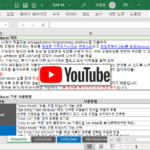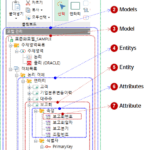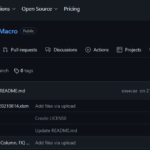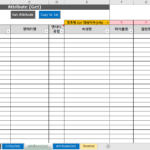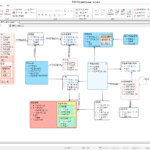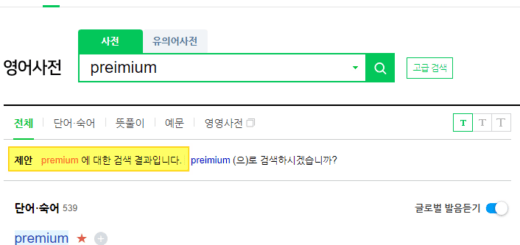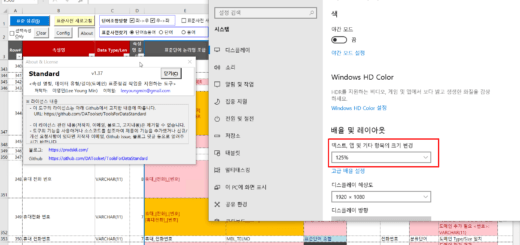DA# Macro(2): DA# Macro Function(1)-Common Function, Entity Get/Set
In this article, Da# Macro common function Entity Get/Set function will be reviewed.
This is a continuation of the previous article.
DA# Macro(1): DA#, DA# API, DA# Macro Overview
2. DA# Macro function
DA# Macro function is largely divided into common functions, Entity Get/Set, Attribute Get/Set, and Reverse.
2.1. DA# Macro Common Functions
Commonly applied to Entity(Get), Entity(Set), Attribute(Get), and Attribute(Set) sheets.
2.1.1. Select Model
To execute the functions provided by each sheet, the “Select Model” window must be running.
- Add model file: Add model file to execute macro. You can select and add multiple files in one directory, or you can continue to add multiple files in another directory.
- Add Open Model: If DA# is running, add the currently open model to DA#. You can also add models that have not yet been saved.
- Save & Close: This is an option to save and close when processing of one file is completed while executing Macro in turn for the model files added to the list. If checked, opens each file, processes it, saves it, and closes it. If it is not checked, it is opened and processed without saving. If there are many model files to process, keeping the model files open will consume a lot of memory, so it is recommended to check the “Save & Close” option. The Get function operates only to close without saving.
- Initialize List: Remove all model files added to the list.
- Remove Selected Files: Removes only the selected files from the list. (Shift + Click to select multiple consecutive files, or Ctrl + Click to select and remove non-contiguous multiple files)
2.1.2. Clear List
DA# Deletes the contents printed on the Excel sheet as a result of Macro execution.
2.2. DA# Macro Entity Get/Set
2.2.1. Entity Get
- Get Entity: Opens the models selected in the “Select Model” window one after another and brings the attribute information of all entities into Excel. At this time, only the attribute items selected in line 3 “Get target by item (Y/N)” are imported. If the item is not absolutely necessary, you can set the target to “N” to speed up the execution time.
- The attribute information of the entity imported into Excel is as follows.
- model name
- entity name
- table name
- synonym
- auxiliary name
- DB Owner
- Classification: One of Key, Main, Action, or None
- Level
- Stage: either essential or practical
- Type: One of Normal, Additional, Drop, External, Pseudo
- Standardization: one of inheritance, target, or non-target
- situation
- cycle of occurrence
- monthly amount
- Retention period (months)
- total number of cases
- Justice
- data processing form
- Uniqueness
- Note
- Tag
- Copy to Set: Copy the model name and entity name imported by “Get Entity” to the “Entity(Set)” sheet.
- User Defined Property (UDP) values defined in entities You can import it by entering the UDP name in line 4 in . The UDP name must be entered correctly. If there is no UDP defined in the selected model or there is no matching UDP name, the UDP value is not imported.
- Precautions
- The X column where the UDP entry begins must not be deleted.
- UDP items after column Y can be added/deleted and the order can be changed.
- You cannot add/delete/reorder items in columns A to V and blank column W.
2.2.2. Entity Set
- Standard value: Select whether to find the target entity to be changed in column B (model name) by “entity name” or “table name”.
- Append Mode: Appends the content written in the Excel sheet to the current value for “Definition”, “Data processing type”, “Special item”, and “Note” items among entity characteristics. It should be noted that this does not apply to all items.
- Entity property information that can be changed is as follows. The properties 'classification', 'level', 'type' and 'normalization' must be written with one of the predefined values.
- entity name
- table name
- synonym
- auxiliary name
- DB Owner
- Classification: One of Key, Main, Action, or None
- Level
- Stage: either essential or practical
- Type: One of Normal, Additional, Drop, External, Pseudo
- Standardization: one of inheritance, target, or non-target
- situation
- cycle of occurrence
- monthly amount
- Retention period (months)
- total number of cases
- Justice
- data processing form
- Uniqueness
- Note
- Tag
- Set Entity: Opens the models selected in the “Select Model” window one after another and reflects the entity property information written in the Excel sheet to the model and the entity. Similar to the “Get Entity” function, only the attribute item selected in line 3 “Get object by item (Y/N)” is reflected.
- The entity UDP value to change is write in If the UDP name does not exactly match, the value is not reflected.
- Precautions
- Column Z, where the UDP entry begins, must not be deleted.
- UDP items after column Z can be added/deleted and the order can be changed.
- You cannot add/delete/reorder items in column A to column X and blank column Y.
So far, we have looked at common functions and Entity Get/Set functions among DA# Macro functions. Next, we will look at the Attribute Get/Set function.
<< List of related articles >>
- DA# Macro(1): DA#, DA# API, DA# Macro Overview
- DA# Macro(2): DA# Macro Function(1)-Common Function, Entity Get/Set
- DA# Macro(3): DA# Macro Function(2)-Attribute Get/Set
- DA# Macro(4): DA# Macro Function(3)-Reverse
- DA# Macro(5): Usage notes/notes, downloads, features to be added in the future, notes
- DA# Macro(6): DA# Modeler API
- DA# Macro function demonstration video (YouTube)
- DA# Macro Description Contents , Download








